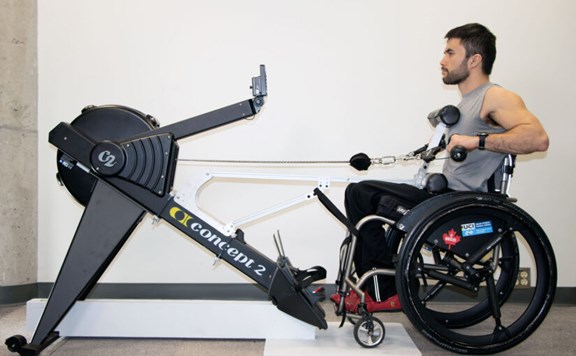A project led by a Burnaby researcher aims to develop adaptations that allow commercially available rowing machines to be used by wheelchair users, thus making rowing an accessible, effective, and enjoyable exercise for people with spinal cord injury and other disabilities.
BCIT Burnaby researcher Dr. Jaimie Borisoff is the Canada research chair in Rehabilitation Engineering Design, an ICORD Principal Investigator, and someone who lives with an SCI.
Borisoff recently collaborated with Burnaby SFU researcher, ICORD Principal Investigator and project lead Dr. Carolyn Sparrey and Dr. Bonita Sawatzky, UBC researcher and ICORD Principal Investigator, to develop a rowing ergometer for people with disabilities.
“We call it the AROW, which is short for Adapted Rowing Machine,” says Borisoff. “The device consists of a support arm that connects to the front end of a standard rowing machine you would find in a community gym. The arm provides adjustable chest and lap supports to stabilize use from a wheelchair.” It is important to note that the AROW isn’t a device exclusively for use by wheelchair users, as it can also be used as seated exercise by seniors and those with physical limitations that prevent them from using a standard rowing machine.
Borisoff’s Rehabilitation Engineering Design Lab (REDLab) at BCIT specializes in applied research that aims to find solutions and provide commercially viable products in a timely way. Creating an inexpensive and accessible device were key requirements for the AROW.
“To encourage community gyms and other facilities to provide an alternative accessible exercise option, we wanted a product that could be available as soon as possible and with a limited financial commitment,” Borisoff says.
The AROW completed extensive testing with diverse users and in various settings. This allowed researchers to confirm the viability and feasibility of the device’s design and benefits. The testing included a physiology study that compared AROW with an arm-cycle exerciser. Results showed that participants really liked the AROW because it uses different muscles than wheeling. As well, for a given workload, users were able to achieve a higher heart rate and expend more energy, thus achieving a more intense workout.
Making exercise accessible across Canada
A key part of this research is to be able to embed accessible exercise options where people are, with the goal of making exercise convenient and more feasible. BCIT REDLab has built eight units of AROW that will be installed in community gyms across Canada. Six units will be located in BC, and one will be placed in the Canadian Paralympic wheelchair basketball training centre in Ontario. To support users, an online resource is available with design plans, demonstration videos, instructions, and links to additional resources for adapted rowing—for example, harnesses, binders, gloves, handles, and grips.



